- What is performance management culture?
- 7 elements of modern performance management that shape culture
- How your performance management approach influences company culture
- How to weave performance management into company culture
- Integrate performance management into onboarding
- Align performance metrics with business outcomes
- Embed performance conversations into leadership development
- Incentivize performance management participation
- Adopt technology to make performance management seamless
- Make performance a shared responsibility
- Audit and evolve your performance practices regularly
- Make performance management culture a competitive advantage
Your company’s performance management culture tells employees what you truly value. If feedback is rare, goals are unclear, and development is an afterthought, employees will notice. And according to new research, many already feel that their company’s system isn’t working.
Only 46% of individual contributors report experiencing full performance enablement, and just 49% feel positive about their current performance management process, according to the 2025 State of Performance Enablement report. That means more than half of employees don’t believe their company is giving them the tools, feedback, and support they need to succeed. When performance management and culture are misaligned, employees feel disengaged, uncertain about expectations, and disconnected from growth opportunities.
To build a strong performance management culture, you need more than just a performance management system. You must align organizational culture and performance management to create a workplace where employees thrive.
Explore the performance management elements that shape culture, and how you can make performance management processes an integral part of your company’s cultural DNA.
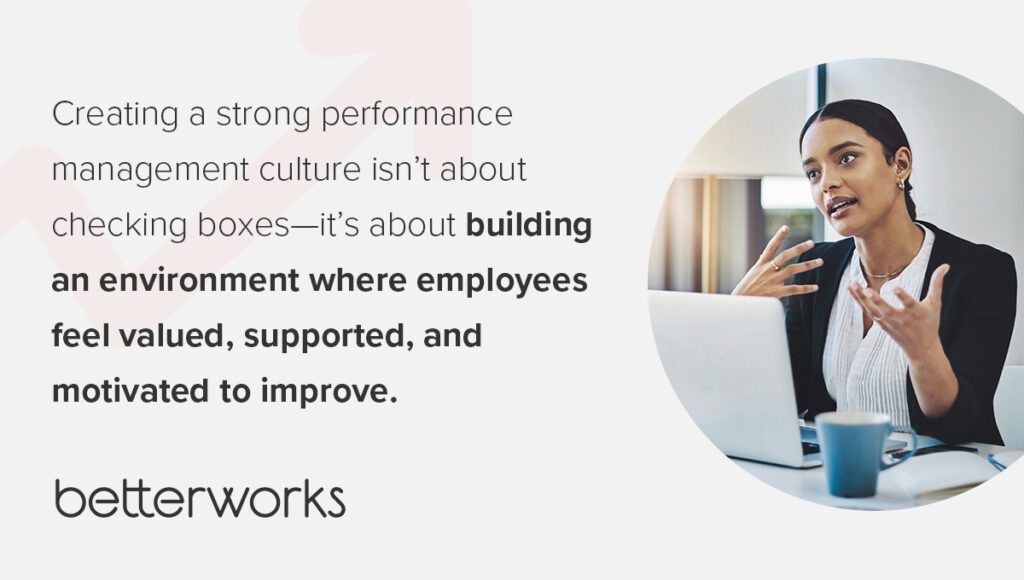
What is performance management culture?
Performance management culture is the way your company sets goals, gives feedback, and develops employees to drive high levels of performance. When you integrate performance management processes into daily work, employees feel engaged, managers become better coaches, and performance improves. A strong performance management culture creates a workplace where employees see their impact and continuously grow.
7 elements of modern performance management that shape culture
A strong performance management culture doesn’t happen by chance. It requires clear goal setting, ongoing conversations, and a commitment to employee growth. These seven elements define how performance management and culture work together to create high-performance teams.
Organization-wide goal alignment
Employees are more likely to stay engaged when they can see how their work supports company-wide goals. Without clear goal alignment, they’re at higher risk of losing focus, which can lead to disengagement and lower overall performance. “If people aren’t connected to and excited about their organization’s vision, then accomplishments across the company are going to be so much less than they would be with an engaged employee base,” says Andrea Lagan, chief operating officer at Betterworks.
A strong performance management system ensures that individual performances contribute to long-term business success. Goal alignment also reinforces company culture by making expectations clear and helping employees see the impact of their contributions. Encouraging team members to set both personal development goals and strategic business goals ensures a balance between company objectives and individual growth.
Commitment to continuous feedback
Employees need regular feedback—not just an annual review—to perform at their best. Without continual feedback, employees operate in uncertainty, unsure if they’re meeting expectations. When feedback only happens once or twice a year, problems persist longer than they should, and employees miss opportunities to make improvements in real time.
Building a culture of ongoing feedback requires you to build coaching and guidance into the day-to-day employee experience. Managers should provide real-time insights on performance, acknowledge wins, and help employees course-correct when necessary. These are lightweight touches, not burdensome ones, that help employees and teams stay on track. AI-powered tools can help collect feedback throughout the year, making it easier for managers to provide relevant, data-backed insights.
Strong manager and employee relationships
Your performance management culture is shaped by the relationships between managers and employees. A strong relationship creates trust, which leads to higher levels of engagement and long-term retention. “When that relationship between managers and employees is strong, it helps managers know where employees need help, how they can coach them, how they can develop them,” says Paul Agustin, Betterworks’ senior director of solutions engineering.
Managers must move beyond simply evaluating performance — they should act as coaches and mentors who support continuous learning and improvement. When managers check in regularly, provide meaningful feedback, and show genuine investment in their employees’ success, they create an environment where employees feel valued, motivated, and confident in their growth potential.
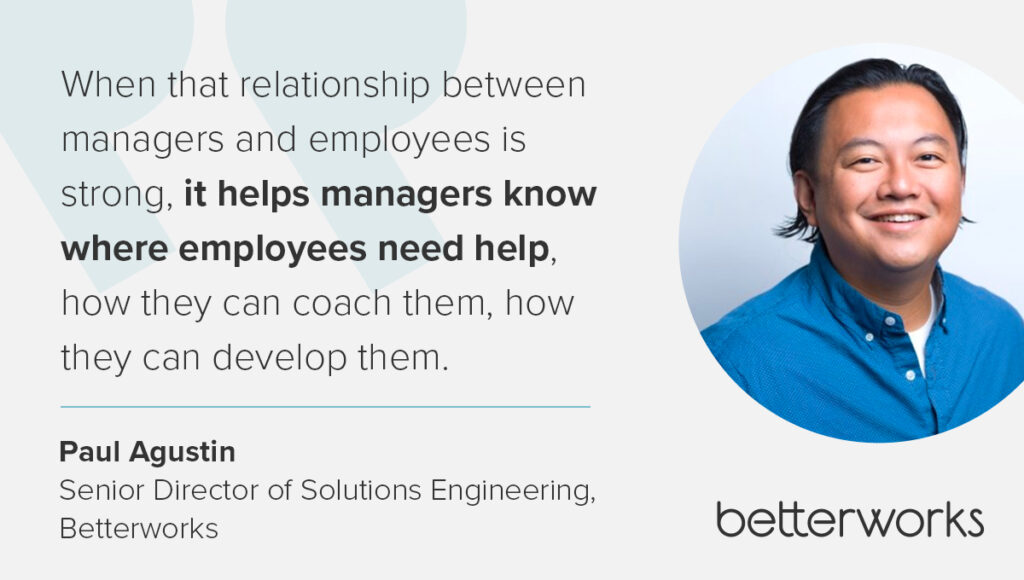
Meaningful 1:1 meetings
One-on-one meetings aren’t just status updates — they’re opportunities for coaching, alignment, and development. Without meaningful check-ins, employees can feel disconnected from their managers and their work. “Having somebody who can provide positive feedback and reassurance is an incredibly empowering moment in an employee’s day,” says John Schneider, CMO at Betterworks.
Use these conversations to provide performance feedback, track progress, and discuss career goals. Regular check-ins help employees stay engaged and committed to continuous improvement.
One-on-one conversations aren’t limited to managers and employees. Peer check-ins, cross-functional discussions, feedback, and skip-level meetings can also reinforce a high-performance culture. When employees have the opportunity to connect with colleagues outside their direct reporting structure, they gain new insights, build relationships, and align their work with broader company objectives. Expanding the scope of one-on-one interactions fosters a culture of collaboration, mentorship, and shared accountability for performance.
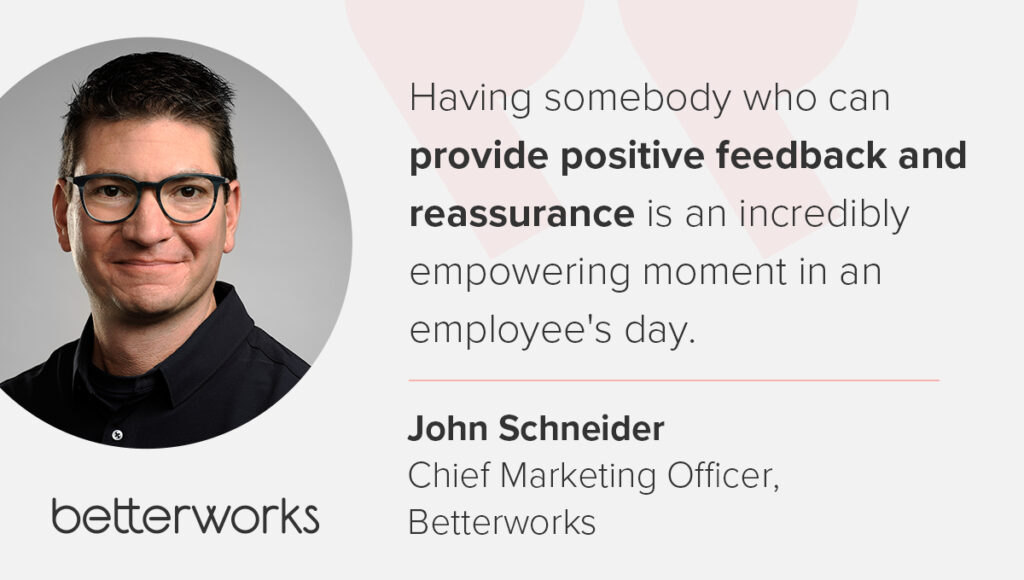
Clear employee development pathways
Your employees want to grow. Without clear development pathways, they’ll seek opportunities elsewhere. A strong performance management culture helps employees feel valued and supported in their long-term careers.
Development isn’t just about promotions and job changes—it’s about helping employees build new skills, take on stretch assignments, and prepare for future roles that are meaningful to them and the organization. Encouraging employees to pursue training, mentorship, and career planning discussions helps them stay engaged and motivated. AI-powered learning tools can help track employee progress, suggest relevant skill-building opportunities, and personalize development plans based on career goals and business needs.
Consistent calibration
Without a fair and consistent approach to performance evaluations, employees lose trust in the system. Calibration keeps performance reviews and goal assessments fair, data-driven, and aligned across teams. “We’re creating more equitable distribution across the organization, and we’re using data to better understand how our employees are performing,” says Caitlin Collins, organizational psychologist and Betterworks program strategy director. When done effectively, calibration helps retain high performers by ensuring internal mobility decisions—such as promotions and career advancements—are based on merit, not just manager perception.
Betterworks enables you to calibrate performance data as often as needed, not just annually by simplifying and speeding up the process. This flexibility allows leaders to identify top talent, adjust career pathways in real time, and create new opportunities for high performers before they start looking elsewhere.
AI-enabled performance management systems
AI is transforming performance management processes by providing real-time insights and automating administrative tasks. “It can be challenging to get individuals to engage in some of these processes that maybe in the past have felt a bit labor intensive,” says Cheryl Johnson, chief product and technology officer at Betterworks. “And so there’s really this opportunity to leverage generative AI in HR that make these processes much more efficient.”
An AI-enabled performance management system like Betterworks makes it easier to track progress, share feedback, and craft employee growth plans. That has a big impact on how people experience performance management. When AI is used in performance management, 89% of managers and employees report high satisfaction, according to the 2025 State of Performance Enablement report. By contrast, 40% of employees without AI-enabled performance management tools report being satisfied.
By surfacing performance patterns and recommending coaching strategies, AI helps managers and employees make informed decisions. These insights also identify skill gaps, refine team structures, and foster a culture of continuous learning and improvement.
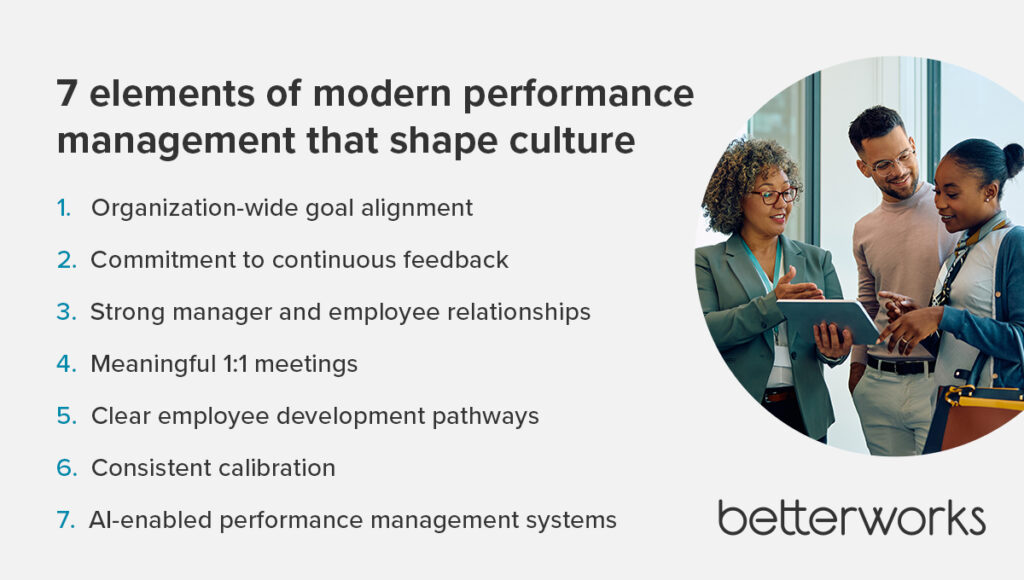
How your performance management approach influences company culture
Your approach to performance management and culture shapes how employees engage, develop, and perform. When done well, it fosters growth, accountability, and motivation. When done poorly, it creates disengagement, uncertainty, and turnover. Here’s how different approaches impact your company culture.
Annual reviews vs. continuous feedback
Relying only on an annual review creates a culture of uncertainty. Employees go months without knowing if they are on track, which leads to stress, disengagement, and misalignment. “Unless it’s all positive news, the impact it has on people, from a process standpoint, isn’t that great,” Caitlin says.
Furthermore, when feedback is infrequent, small problems become big ones, and employees miss opportunities to improve. This type of performance management process can make employees feel undervalued and disconnected from the company’s goals.
A continuous feedback culture creates a workplace where employees know where they stand and how they can grow. Regular conversations between managers and employees reinforce progress, clarify expectations, and help employees make real-time improvements. Employees feel more supported, more engaged in their work, and more confident in their ability to succeed. This builds a culture of trust, learning, and improvement, where employees feel valued and performance is always improving.

Performance improvement plans (PIPs) vs. coaching culture
A performance management process that relies too heavily on performance improvement plans (PIPs) creates a culture of fear and avoidance. Employees often see PIPs as a punishment rather than an opportunity to improve. When performance management only happens after mistakes, employees may feel unsupported and disengaged. This reactive approach can make employees afraid to take risks or seek help, weakening overall performance.
A coaching culture, on the other hand, builds a workplace where continuous learning and support are part of the norm. Managers proactively work with employees to develop their skills, set goals, and overcome challenges before they become serious issues. Employees feel safe asking for help and know that performance management is there to help them succeed, not punish them for struggling. Over time, this approach builds a culture of growth, open communication, and high performance, where employees are motivated to improve and managers feel empowered to develop their teams.
A coaching culture… builds a workplace where continuous learning and support are part of the norm. Managers proactively work with employees to develop their skills, set goals, and overcome challenges before they become serious issues.
Isolated tasks vs. transparent initiatives
If employees don’t see how their work connects to strategic company initiatives, they may start to feel lost or disengaged. A performance management system that lacks goal alignment can lead to miscommunication, unclear priorities, and frustration. Employees who don’t understand their impact are less likely to take ownership of their work, leading to a culture of disengagement where employees feel like their contributions don’t matter.
When goal-setting is transparent and aligned with business objectives, employees understand why their work matters. Developing a high-performance culture helps team members see their progress, track their contributions, and adjust when needed. This creates a culture of purpose and accountability, where employees are more engaged, more focused, and more motivated to succeed.
How to weave performance management into company culture
HR leaders play a critical role in embedding performance management processes into the day-to-day rhythm of work. Beyond goal setting and feedback, here’s how you can operationalize performance management to strengthen your company culture and improve overall performance.
Integrate performance management into onboarding
Set the tone from day one by making performance expectations, goal setting, and feedback cycles a core part of onboarding. Introduce new hires to your performance management system early so they understand how success is measured and how they’ll receive support. Provide training on continuous improvement and how your company uses performance reviews as a tool for growth rather than a compliance exercise.
Align performance metrics with business outcomes
Your performance management culture will only take root if employee performance is measured in ways that directly support business objectives. Work with senior leadership to ensure that performance goals align with long-term company strategy and that managers can clearly connect individual performances to broader success. Make performance data accessible so employees and leaders can track progress in real time.
Embed performance conversations into leadership development
Strong managers and employees drive a performance management culture, but many managers lack the skills to give effective feedback or hold meaningful one-on-one check-ins. Build performance management strategies into leadership training programs, coaching managers to integrate day-to-day performance discussions into their workflow.
Incentivize performance management participation
If managers and employees don’t see performance management as valuable, they won’t engage with it. Reinforce the importance of continuous learning and feedback by recognizing leaders who excel at coaching and employees who actively seek growth opportunities. Consider tying manager effectiveness in performance management to leadership evaluations and promotions.
Adopt technology to make performance management seamless
A performance management system should make tracking performance, collecting feedback, and adjusting goals easy and efficient. Performance management tools should integrate with existing workflows, such as project management systems, HR platforms, and talent engagement software. AI-powered insights can help identify high levels of performance, flag areas for improvement, and encourage employees to stay on track.
Make performance a shared responsibility
Performance management isn’t just an HR initiative—it should be owned by leaders at every level. HR can provide the framework, but executives, managers, and employees need to take an active role. Create cross-functional partnerships to reinforce performance expectations and embed accountability into company culture. When everyone takes ownership of performance management processes, these become second nature.
Audit and evolve your performance practices regularly
Even the best performance management strategies need to evolve. Conduct regular audits to make sure that your performance management culture remains effective and aligns with company growth. Use employee feedback and performance reviews to refine processes, eliminating anything that feels redundant or ineffective. Adapt your approach based on business needs while keeping the core principles of goal alignment, feedback, and employee development intact.
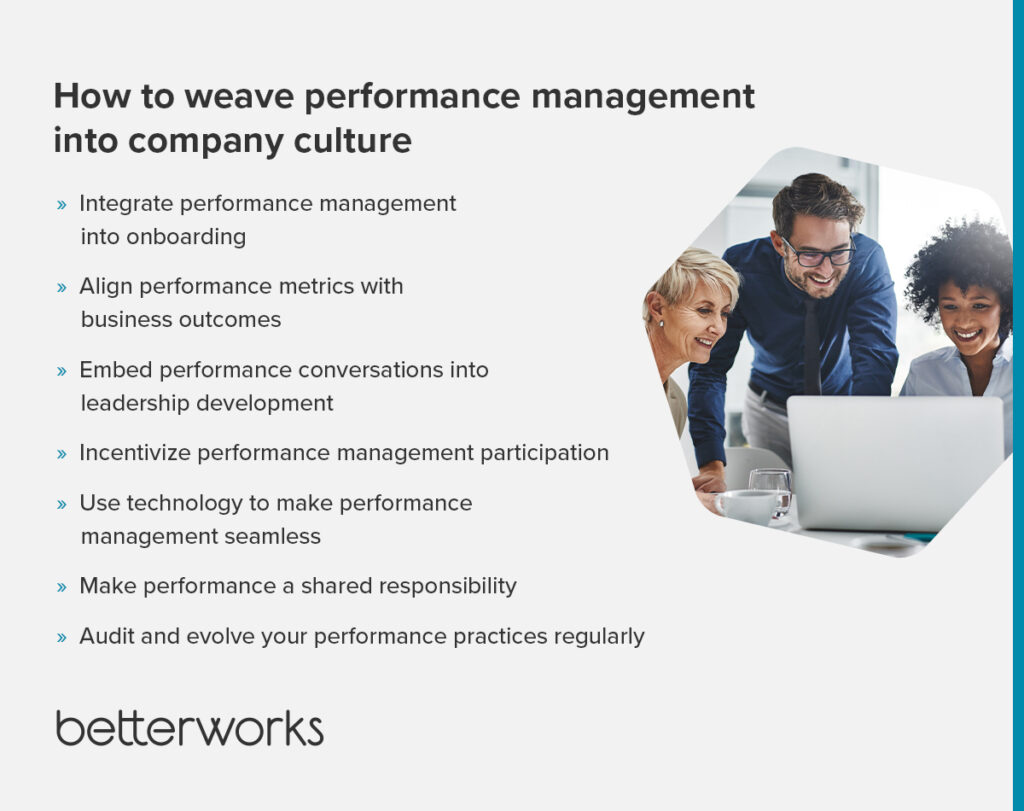
Make performance management culture a competitive advantage
Creating a strong performance management culture isn’t about checking boxes — it’s about building an environment where employees feel valued, supported, and motivated to improve. Betterworks enables this by embedding goal setting, continuous feedback, and manager coaching into the daily flow of work. With AI-driven insights, you can track progress, identify growth opportunities, and ensure that performance conversations are meaningful and data-driven.
A high-performing culture happens when performance management and culture work together. Betterworks provides the tools to align goals, streamline feedback, and empower managers, making performance management an ongoing, strategic advantage. When your performance management system reinforces your culture, you drive better results, improve retention, and create an organization where employees want to grow and succeed.
Want to learn more? Download your copy of the 2025 State of Performance Enablement report.
Achieve an optimal performance culture


